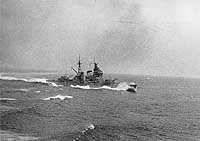
Haguro, a 10,980-ton (standard displacement) Myoko class heavy cruiser, was built at Nagasaki, Japan. She was commissioned in April 1929 and served until 1933 with the Fourth Squadron (Sentai) and after that with the Fifth Sentai. During the years prior to the Pacific War the cruiser operated in Japanese home waters and off China, taking part in peacetime maneuvers. She carried troops to China in 1932 and in 1937. During the latter year, as Japan and China began open warfare, Haguro participated in blockade, patrol and landing operations along the Chinese coast.
In 1935-1936 and again in 1939 Haguro was in shipyard hands for modifications. Among other things, this work significantly enhanced her torpedo armament, improved her antiaircraft gun batteries and altered her aircraft handling arrangements. Though her combat power was thus improved, her beam and displacement were also increased, resulting in a modest decrease in maximum speed. In 1940 and 1941 Haguro actively took part in the Japanese fleet's preparations for war against the United States and other Western powers. She was sent to the Palau Islands in November 1941 and, after the Pacific War began in December, participated in landings in the Philippines. During the first few months of 1942 she took part in the conquest of the Netherlands East Indies and played an important role in the Battle of the Java Sea.
Haguro was also present, with the Japanese main aircraft carrier force, during the Battle of the Coral Sea in May. In the next month's Battle of the Midway, she was part of the Midway Occupation Force. In late August she took part in the Battle of the Eastern Solomons, first of the Guadalcanal Campaign's two aircraft carrier actions. In January-February 1943, as that long struggle neared its end, Haguro provided distant cover for Japan's successful effort to evacuate its troops from Guadalcanal. She was in the Northern Pacific in May and June 1943, returned south as the Allies moved into the Central Solomons and fought in the Battle of Empress Augusta Bay at the beginning of November.
As part of the First Mobile Fleet, Haguro took part in the June 1944 Battle of the Philippine Sea. On 24-25 October she was in action in the Sibuyan Sea and off Samar, two of the components of the Battle of Leyte Gulf. In 1945 Haguro was stationed at Singapore, from which she carried out supply and transport missions. In the early hours of 16 May 1945 she was intercepted by five British destroyers while conducting such an operation to evacuate the Andaman Islands, in the eastern Bay of Bengal. Haguro was hit by three torpedoes and sunk, with the loss of about three-quarters of her crew of some 1200 officers and men.
This page features all the images we have concerning the Japanese cruiser Haguro.
| If you want higher resolution reproductions than the digital images presented here, see: "How to Obtain Photographic Reproductions." |
Click on the small photograph to prompt a larger view of the same image.
|
Photo #: NH 90783 Haguro (Japanese Heavy Cruiser, 1929) In the final stages of fitting out, off Mutusbishi's Nagasaki shipyard, 6 April 1929. Photographed by Lieutenant R.J. Townsend, USN, of USS Black Hawk (AD-9). The original print is in Office of Naval Intelligence Register Number 16068-a, in U.S. National Archives Record Group 38, Entry 98, Box 1269. U.S. Naval History and Heritage Command Photograph. Online Image: 62KB; 740 x 605 pixels |
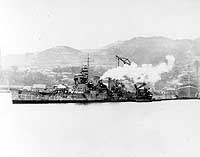 |
|
Photo #: NH 51898 Haguro (Japanese heavy cruiser, 1929) Off the mouth of the Yangtse River near Shanghai, China, 1932. U.S. Naval History and Heritage Command Photograph. Online Image: 50KB; 740 x 600 pixels |
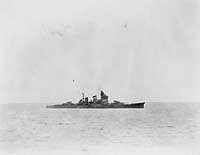 |
|
Photo #: NH 88373 Haguro (Japanese Heavy Cruiser, 1929) Photograph probably taken between December 1931 and November 1932, when she was the third-ranking ship of Cruiser Squadron 4, Fourth Fleet. Japanese inscription in the lower right reads (from right to left): "Large cruiser Haguro, Myoko". U.S. Naval History and Heritage Command Photograph. Online Image: 86KB; 740 x 505 pixels |
 |
|
Photo #: NH 73016 Haguro (Japanese Heavy Cruiser, 1929) Underway in April 1936. Donation of Kazutoshi Hando, 1970. U.S. Naval History and Heritage Command Photograph. Online Image: 119KB; 740 x 575 pixels |
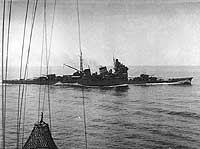 |
|
Photo #: NH 73017 Haguro (Japanese Heavy Cruiser, 1929) Operating at high speed, 1936. Donation of Kazutoshi Hando, 1970. U.S. Naval History and Heritage Command Photograph. Online Image: 136 KB; 740 x 545 pixels |
 |
|
Photo #: NH 73018 Haguro (Japanese Heavy Cruiser, 1929) Steaming through the wake of another Japanese cruiser, 1937. Note the 127mm/40 twin antiaircraft gun and gun director in the foreground. Donation of Kazutoshi Hando, 1970. U.S. Naval History and Heritage Command Photograph. Online Image: 74KB; 740 x 545 pixels |
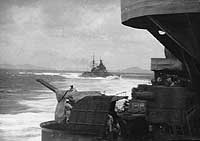 |
|
Photo #: NH 95558 Simpson Harbor, Rabaul, New Britain Aircraft of the USAAF 3rd Bomb Group attack Japanese ships in Simpson Harbor, 2 November 1943. The heavy cruiser Haguro is in the foreground. She had been somewhat damaged during the battle of Empress Augusta Bay the previous night. The burning transport at right appears to be one of the Hakone Maru class, of which Hakone Maru, Hakozaki Maru and Hakusan Maru were still afloat at the time. The ship in the left distance, partially hidden by smoke, appears to be the submarine tender Chogei or Jingei. Official U.S. Air Force Photograph, from the collections of the Naval History and Heritage Command. Online Image: 65KB; 740 x 555 pixels |
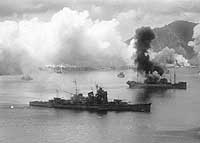 |
|
Photo #: NH 82476 Simpson Harbor, Rabaul, New Britain Attack on Japanese shipping in Simpson Harbor by aircraft of the USAAF 3rd Bomb Group, 2 November 1943. The heavy cruiser Haguro is in the upper right center, beyond the bomb splashes. The ship in the center distance appears the submarine tender Chogei or Jingei. The original photograph came from Rear Admiral Samuel Eliot Morison's World War II history project working files. Official U.S. Air Force Photograph, from the collections of the Naval History and Heritage Command. Online Image: 131KB; 690 x 635 pixels Note: An earlier identification of this photograph as having been taken during the 5 November 1943 Rabaul raid by USS Saratoga (CV-3) is not correct. |
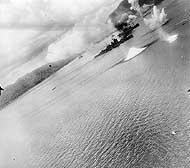 |
|
Photo #: NH 95559 Simpson Harbor, Rabaul, New Britain Attack on Japanese ships in Simpson Harbor, by aircraft of the USAAF 3rd Bomb Group, 2 November 1943. The heavy cruiser Haguro is partially visible at left, with what appears to be the submarine tender Chogei or Jingei beyond. The burning transport in the left center appears to be one of the Hakone Maru class, of which Hakone Maru, Hakozaki Maru and Hakusan Maru were still afloat at the time. Official U.S. Air Force Photograph, from the collections of the Naval History and Heritage Command. Online Image: 94KB; 740 x 585 pixels |
 |
|
Photo #: NH 95560 Simpson Harbor, Rabaul, New Britain A bomb explodes off the port quarter of a Japanese cargo ship (at right) during an attack on Simpson Harbor by aircraft of the USAAF 3rd Bomb Group, 2 November 1943. The heavy cruiser Haguro is in the center distance. A low-flying B-25 bomber is visible in the lower left. Official U.S. Air Force Photograph, from the collections of the Naval History and Heritage Command. Online Image: 55KB; 740 x 375 pixels |
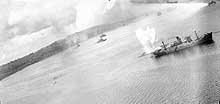 |
|
Photo #: 80-G-272555 Battle of the Sibuyan Sea, 24 October 1944 Japanese heavy cruiser Haguro firing at attacking U.S. carrier planes during the Sibuyan Sea action. Official U.S. Navy Photograph, now in the collections of the National Archives. Online Image: 126 KB; 740 x 605 pixels Reproductions of this image may also be available through the National Archives photographic reproduction system. |
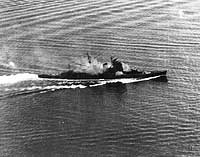 |
The following photograph shows Haguro distantly:
NOTES:
| If you want higher resolution reproductions than the digital images presented here, see: "How to Obtain Photographic Reproductions." |
Page made 22 March 2003
High-resolution images added & photo ID refined 4 January 2011